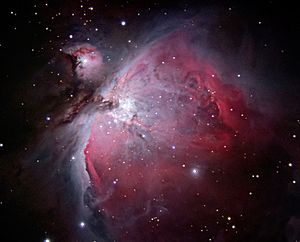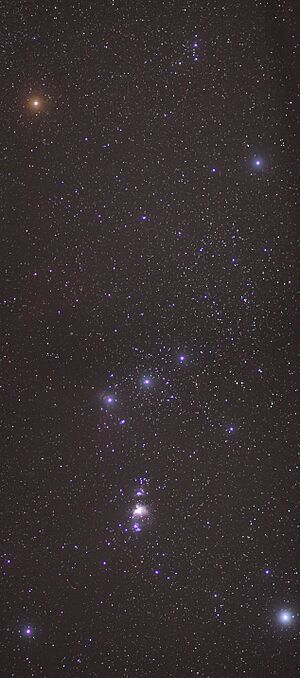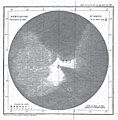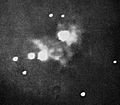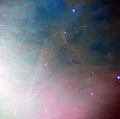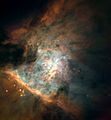Orion nebula facts for kids
The Orion Nebula is a huge cloud of gas and dust in space. It's also known as Messier 42 (or M42) and NGC 1976. This amazing nebula is one of the brightest ones we can see. You might even spot it with your own eyes on a clear night!
The Orion Nebula is about 1,344 light-years away from Earth. It is the closest place where many big stars are being born. You can find it just south of Orion's Belt in the constellation of Orion. Even though the Orion Nebula is huge, it's actually just a small part of an even bigger area called the Orion complex. This whole complex is a giant region where stars are forming.
Contents
A Cosmic Star Factory

The Orion Nebula is like a giant "stellar nursery." This means it's a place where many new stars are being born. Scientists believe that about 700 stars are currently forming inside this nebula!
Right at the heart of the nebula is a group of very young stars. This group is called the Trapezium because its brightest stars form a shape like a trapezoid.
Baby Planets in the Making
Scientists have used the Hubble Space Telescope to look closely at the Orion Nebula. They found something really exciting: tiny disks of gas and dust! These are called protoplanetary disks, or proplyds for short. There are over 150 of these proplyds in the nebula.
These proplyds are thought to be the very first stages of planetary systems forming around new stars. Finding so many of them suggests that making planets might be quite common in the universe!
How Stars Are Born
Stars begin to form when big clumps of hydrogen gas and other materials in a space cloud start to pull together. This happens because of their own gravity. As the gas pulls inward, the center of the clump gets hotter and hotter. This heat comes from the energy released as the gas collapses.
If the temperature gets hot enough, a process called nuclear fusion starts. This is when atoms combine and release a lot of energy. When nuclear fusion begins, the new star is called a protostar. A protostar is "born" when it starts to give off enough energy to stop collapsing under its own gravity.
Images for kids
-
A star chart of the Orion Nebula.
See also
 In Spanish: Nebulosa de Orión para niños
In Spanish: Nebulosa de Orión para niños


